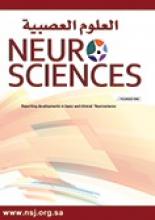Hypoglycemia is the most common metabolic disorder that may cause neonatal encephalopathy and result in permanent brain injury.1 Prompt diagnosis is important as urgent treatment may change the progression of the disease and the future prognosis. Conventional MRI is useful to demonstrate the signal changes that are prominent on the occipital lobes; however, MRI may not show the pathology in the very early period. Diffusion-weighted-imaging (DWI) should be obtained prior to other sequences to show any early signal changes that are not visible on MRI.
We report a 3-day-old baby who was admitted to the emergency room with the complaint of poor feeding and cyanosis. There was no problem perinatally, Apgar score was 10 on the first and fifth minutes, and the physical examination was normal at birth and when discharged from the hospital. At the time of admission, he had generalized seizures. The laboratory tests showed severe hypoglycemia, blood glucose level was 21 mg/dl (normal value 50-80 mg/dl). He was given 2cc/kg 10% dextrose, control blood glucose was 78 mg/dl and saturation was 95%. Fifteen minutes later, the blood glucose decreased again (32 mg/dl) and 100 cc/kg 10% dextrose was injected. Despite these injections, control glucose levels were 42, 47, and 57 mg/dl, and during the acute treatment, seizures repeated. Antiepileptic drugs were started (Phenobarbital 20mg/kg infusion and 5 mg/kg maintenance dose) and dextrose was continued. An MRI of the brain was performed after the cessation of the seizures. The conventional MRI was normal except for suspicious faint signal increase on the left occipital lobe. Fluid-attenuated inversion recovery (FLAIR) sequence showed no signal changes (Figure 1A). However, diffusion weighted MRI showed significant perirolandic and right occipital diffusion restriction, which was hyperintense on DWI and hypointense on apparent diffusion coefficient map (Figure 1B). The left occipital lobe was normal. An MR angiography was also normal ruling out any vascular occlusion. During follow-up, he did not have any more seizures and serum blood glucose was within normal range. Ten days later he was discharged with per oral Phenobarbital (2 × 9 mg) and Diazoxide (3 × 20 mg). An informed consent was obtained from his parents.
Axial fluid-attenuated inversion-recovery image A) does not show any abnormal signal. Apparent coefficient map (ADC) shows B) restriction of diffusion on the right insula, posterior parietal, and left parietal lobes.
Neonatal hypoglycemia is associated with corticospinal tract injury and adverse motor and cognitive outcomes.2 Infants who are small for gestational age, the smaller of the twins, babies of toxemic mothers, hypocalcemic, and polycythemic patients are at risk for hypoglycemia; however, there may not be an underlying cause at all times.3 Although it is not easy to distinguish hypoxic ischemic encephalopathy and hypoglycemic encephalopathy, various injury patterns in hypoglycemia are described based on MRI findings. Wong et al4 showed that selective posterior white matter and pulvinar edema were most predictive of clinical hypoglycemia, and no injury or a watershed pattern of injury was seen more often in severe hypoglycemia. The conventional MRI is good at showing increased signal on FLAIR or T2-weighted imaging; however, it may not be sensitive in the very early period. The DWI is also important as well as conventional techniques. Our case did not show any abnormal signal intensity on T2-weighted and FLAIR imaging on the regions that showed restriction of diffusion on the DWI. The DWI is not only necessary to distinguish vasogenic edema versus cytotoxic edema, but also leads to the diagnosis itself in case of normal conventional MRI findings.
In conclusion, in neonates who are suspicious for hypoglycemic encephalopathy and have poor sedation, priority should be given to DWI before other sequences and the protocol should be organized accordingly.
- Received November 5, 2014.
- Accepted May 8, 2015.
- Copyright: © Neurosciences
Neurosciences is an Open Access journal and articles published are distributed under the terms of the Creative Commons Attribution-NonCommercial License (CC BY-NC). Readers may copy, distribute, and display the work for non-commercial purposes with the proper citation of the original work.







